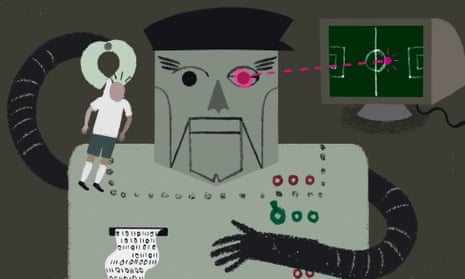Few footballing figures have attracted such a solemnly tended mythology as Valeriy Lobanovskiy, the coach of Dynamo Kyiv and Ukraine in the late Soviet years. Wreathed in an ancient silence beneath his worker’s cap, Lobanovskiy was a monolithic presence during the TV coverage of the 1988 European Championship, appearing suddenly in Stalinist close-up, vast concrete jowls framing the screen, sphinx-like, eternal, as old as the steppes. He was, the internet reveals, only 49 at the time. But presumably being potent, eternal, all-seeing and so on takes it out of you.
Lobanovskiy is usually cast as the father of things. Father of analytics. Father of a data-driven total football. At times he has been portrayed as a piece of Soviet industrial-sporting machinery made flesh, players reduced to units of human value, blobs beeping away on the screen of his vast beige computer monitor.
But he was clearly very human too. Famously, Lobanovskiy’s Soviet Union team at those Euros was cut down from 40 players based on a series of tests, every movement tracked, rated and tessellated. At the end of which – and this is key – he basically picked all his own Dynamo Kyiv players. Numbers crunched, data unravelled, Lobanovskiy spent 36 hours in standby mode, diodes winking. Then whirred back into life and basically picked all his own Dynamo Kyiv players.
It worked too. The rest of the Soviet Union may have hated him for it but the Dynamo team he coached in his day job knew his system and knew each other. The obsession with team chemistry told him this was the best way to win. Eight of his club players ended up on the pitch in the final against Holland, a game Dynamo (feat special guests) were closer to winning than the 2-0 scoreline suggests.
This is probably the most extreme modern example of a successful one-club national team. But by design or chance it has become the trend. Portugal fielded 10 Sporting Lisbon youth team products at Euro 2016. Germany had seven Bayern Munich players at the last World Cup. The 2010 World Cup final was basically Ajax juniors v Barcelona juniors. Italy’s 2006 world champs had five Juventus players. Greece had five from Panathinaikos in 2004. It goes on. It makes sense. So why not in England?
This is in part just a matter of curiosity. England have stunk the place out at four successive tournaments. They were the most tedious guests at the last Euros but there is talent out there, so why not try something else? Why not pick a midfield and attack entirely from players under the age of 25 playing in the Champions League, who seem to be good enough for three of the best managers in the world?
That Tottenham spine, for example. Eric Dier, Harry Winks and Dele Alli started in midfield against Real Madrid on Wednesday night. They played a high-energy, high-pressing style, driven on by the startling spectacle of a febrile Wembley Stadium. Madrid may have looked old and muddled but they were also made to look that way.
And really: why wouldn’t you jump all over this, import it wholesale into the stodgiest England team in modern memory? What more convincing recommendations do we have lying around the place than outmanoeuvring the European club champions? What kind of arrogance would it take from those picking an England team to assume they can do better? Mm. Yes, Mauricio. Not bad. We’ll keep your details on file. Now. Where were we? Oh yes. DNA. Gareth, fire up the Powerpoint.
This isn’t just a Spurs thing. It’s a Lobanovskiy-style note of pragmatism, of being able to put everything aside and accept the evidence of club football. The rest of the team picks itself in the same way. Raheem Sterling, Harry Kane and Marcus Rashford as a three-man attack, with Adam Lallana there for a note of rotation. Stick this ahead of Dier, Alli and Winks and England have access to a youthful, energetic starting front, all playing in more or less the same system, albeit not the ponderous possession-based England DNA-system. Imagine not wanting this to happen.
And yet, it isn’t going to happen. It doesn’t work like that. England, the England team, England-ness has always been a deeply solemn, conservative entity with its own structure of pecking orders and internal hierarchies. Senior players always cling on too long. Mediocre middleweights serve out their time.
It was obvious even before the last Euros that the Kane-Alli partnership was the best English element in the Premier League, that teasing it out and making it bloom was England’s best hope in attack or defence. But Roy Hodgson lost his nerve, distracted by personality, seniority and the need at all costs to shoehorn the ailing Wazza into the centre of things. That club chemistry was junked. England oozed around France like a putrid, zombified carcass. This is how English football works, clogged by a pecking order of entitlement, even when the likely results are clear enough.
If the England age group successes tell us anything it is that the Premier League academies are capable of churning out talented, winning footballers, for whom the real challenge is simply getting a game on the other side, and that the wider public are hungry to see this happen.
With another tournament already looming England could do much worse than chucking out the chintz and kicking off with that youthful, club-grooved front six. In the process they might just take a note from Lobanovskiy, who worried on even more than England’s clipboard fondlers about method and cultures, but who in practice focused on the close-up details and picked a team that was already a team.

